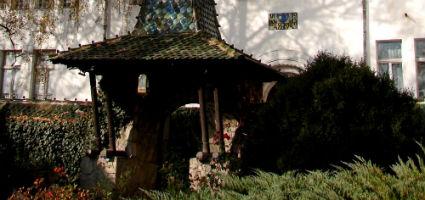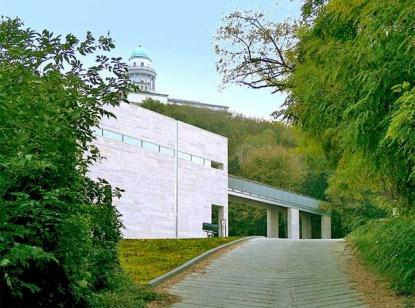2024. May 7. Tuesday
Szekler National Museum - Sfîntu Gheorghe
 |
Address: 520055, Sfîntu Gheorghe str. Kós Károly 10. / Kós Károly u. 10.
Phone number: (267) 312-442
E-mail: office.sznm@gmail.com
Opening hours: Temporarily closed.
|
The exhibition has closed for visitors.
2009.11.12. - 2009.12.07.
Museum tickets, service costs:
|
Individual ticket for adults
|
10 HUF
|
/ capita
|
|
Individual ticket for students
|
5 HUF
|
/ capita
|
|
Group ticket for students
(10-30 people)
|
50 HUF
|
/ group
|
|
Individual ticket for children
(over 7 years of ages)
|
5 HUF
|
/ capita
|
|
Individual ticket for pensioners
|
5 HUF
|
/ capita
|
|
Ticket for families
(2 adults + 1-5 children)
|
20 HUF
|
/ family
|
|
Guide
|
20 HUF
|
|
|
Video
|
20 HUF
|
The exhibition designed by Sándor Tárkányi, János Golda and Tamás Karácsony travelled to Pécs, Budapest, Kolozsvár (Cluj), Nagyszeben (Sibiu), Brassó, Râmnicu Vâlcea before it arrived in Sepsiszentgyörgy to be shown at the Székely National Museum from 11 November to 7 December 2009.

"The material is not to represent a style; there is not preference of taste to educe. It documents the most important works of art by an artist group from the past 20 years" - wrote Krisztina Somogyi in the catalogue for the showing. We really find the extremities and what is in between.
Space is always given, but it can be modified with signs, it can be reconstructed. In this space, in this colourful chaos, family homes and representative buildings, insignificant and significant buildings are lined up as tiny signs. The signs are determined by the era, the requirement of the commissioner, the law, the talent of artist. The seal of these react to space and time, living creatures and human beings and are imprints of a given era in history and the history of architecture.
The best works of art are known nationwide: György Skardelli designed the reception compound at the Pannonhalma Abbey, but the winery by Tamás Czigány, Katalin Csillag and Zsolt Gunther's Audi Forum, Zorán Patartics’s Győr Court are also well-known works. The other end is the shopping centers, industrial plants, soulless block of flats. These are just as documentaries of our times.
The architecture of the 2000's dominating the material, only a few houses were selected from the past century. Over 70 panneaus and a few scale models make up the showing that is accompanied with an 84-page catalogue. The exhibition "SpaceSign" about the architecture of the past two decades in Győr takes account of the most important buildings from the past two decades built in Győr, or in its region, Mosonmagyaróvár, Csorna and Pannonhalma.
There is more than one objective of the exhibition and catalogue: partly we would like to direct attention to the quality of space, the way it is. They also document our times, teach and give ideas, pros and cons about accepting (or not) signs, their usefulness or just the opposite... We really want to direct attention to take account of architecture, especially its values, from the past decades.

"The material is not to represent a style; there is not preference of taste to educe. It documents the most important works of art by an artist group from the past 20 years" - wrote Krisztina Somogyi in the catalogue for the showing. We really find the extremities and what is in between.
Space is always given, but it can be modified with signs, it can be reconstructed. In this space, in this colourful chaos, family homes and representative buildings, insignificant and significant buildings are lined up as tiny signs. The signs are determined by the era, the requirement of the commissioner, the law, the talent of artist. The seal of these react to space and time, living creatures and human beings and are imprints of a given era in history and the history of architecture.
The best works of art are known nationwide: György Skardelli designed the reception compound at the Pannonhalma Abbey, but the winery by Tamás Czigány, Katalin Csillag and Zsolt Gunther's Audi Forum, Zorán Patartics’s Győr Court are also well-known works. The other end is the shopping centers, industrial plants, soulless block of flats. These are just as documentaries of our times.
The architecture of the 2000's dominating the material, only a few houses were selected from the past century. Over 70 panneaus and a few scale models make up the showing that is accompanied with an 84-page catalogue. The exhibition "SpaceSign" about the architecture of the past two decades in Győr takes account of the most important buildings from the past two decades built in Győr, or in its region, Mosonmagyaróvár, Csorna and Pannonhalma.
There is more than one objective of the exhibition and catalogue: partly we would like to direct attention to the quality of space, the way it is. They also document our times, teach and give ideas, pros and cons about accepting (or not) signs, their usefulness or just the opposite... We really want to direct attention to take account of architecture, especially its values, from the past decades.
